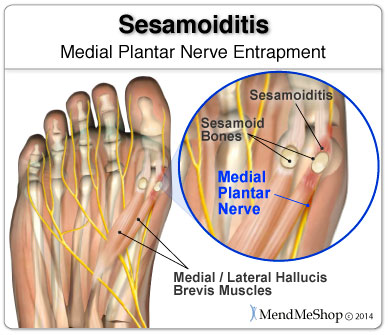There are 3 more injuries that can happen in or around your sesamoid bones resulting in sesamoiditis pain:
- Intractable Plantar Keratosis (IPK) - this is like a callus or corn that's formed on the ball of your foot under your big toe that can cause sesamoiditis-like pain. Over time this callus / corn can develop into a larger lesion with a very painful sore-spot in the center.
If left untreated, this condition can lead to a more serious sesamoiditis injury, reduce range of moition / mobility of your foot and change the way you walk on your foot. Conservative treatment methods are used to treat this injury. Surgery is only ever recommended if you continue to feel pain and have reduced range of motion even after using conservative treatment methods.
- Osteochondritis (Avascular Necrosis) of the Sesamoid Bone(s) - This is a condition where blood supply to 1 or both of your sesamoid bones isn't available. Over time reduced blood flow to your sesamoid bone can actually cause a portion of your bone to die (this is also called 'necrosis'). Your body will try to heal this injury by building up extra calcium (bone) around the dead spot.
This can sometimes happen if you've suffered from a chronic ("stress") fracture in your sesamoid bone that hasn't healed properly. In most cases conservative treatment methods won't work to treat this condition and surgery will be needed to remove the sesamoid bone (reference: 1, 2). If surgery is required, conservative treatment methods can then be used during post-surgery rehabilitation.
- Nerve Entrapment - There is a major nerve that runs near our big toe and second toe called the 'Medial Plantar Nerve'. Even though this nerve is usually not close to the sesamoid bones, nerves can sometimes naturally be in areas where doctors don't expect them to be. It's possible to be suffering from sesamoid pain, with the pain really coming from your medial plantar nerve if it's running under one of your sesamoid bones. If you've had an x-ray and multple tests done to see if you have sesamoiditis or a sesamoid bone fracture and there is no definite result, you might be suffering from nerve entrapment in that area.
Your doctor can see if you have nerve entrapment in this area by doing a test called 'Tinel's Sign'. During this test the doctor will lightly tap near the painful area to see if you feel any tingling or 'pins and needles' sensations. If you feel tingling that runs down your big toe, you might be suffering from nerve entrapment (reference: 1).
- Sesamoid Arthritis - Sometimes you may have cartilage damage under your sesamoid bones between your sesamoinds and the bones in your toes. This cartilage damage can lead to arthritis, a painful inflammatory condition causing stiffness and swelling in your joints. You could have sesamoid pain that is really a case of arthritis under your sesamoid bones. Any signs of arthritis around your sesamoid bones should show up in an x-ray.


No comments:
Post a Comment